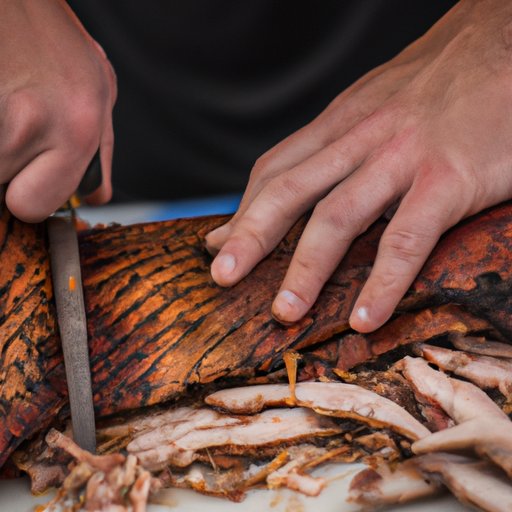
Mastering the Art of Trimming Brisket: A Comprehensive Guide
Trimming a brisket is a crucial step in the barbecue process that can make or break the final product. A well-trimmed brisket allows for even cooking, better seasoning penetration, and creates crispy bark that adds texture and flavor. However, improper trimming can result in a tough and chewy brisket that disappoints even the most dedicated barbecue enthusiasts. In this article, we’ll cover everything you need to know about trimming brisket, from basic techniques to advanced tips from championship-winning pitmasters.
A Beginner’s Guide to Trimming Brisket
Before diving into the specifics of proper trimming, let’s start with the basics. The right tools make all the difference when it comes to trimming brisket. You’ll need a sharp, high-quality knife, preferably a boning knife, to remove the unwanted fat and connective tissue. A trimming board or large cutting board will also come in handy.
Begin the process by removing the fat cap from the brisket, which is the layer of fat on the top of the meat. Use the knife to gently lift the cap away from the meat and slice it off, being careful not to remove too much meat in the process. Once removed, you can also trim off any excess fat from the sides and bottom of the brisket.
The next step is to remove the silver skin, which is a thin, shiny membrane on the bottom of the brisket. This can be tricky, but it’s important to remove it as it can cause the brisket to curl during cooking and prevent seasoning from penetrating the meat. Use the knife to slice under the silver skin and gently lift it away from the meat, taking care not to cut too deep and remove too much meat.
As a beginner, trimming a brisket may seem daunting, but practice makes perfect. Take your time and be patient with yourself, and with each trimming, you’ll get better and more proficient at it. Remember, the goal is to achieve a well-trimmed, evenly-shaped brisket that is ready for seasoning and smoking.
The Art of Trimming Brisket
For experienced pitmasters, trimming brisket is an art form that takes years of practice to perfect. A perfectly trimmed brisket is evenly sized, with a layer of nicely rendered fat and crispy bark on the outside. Advanced trimming techniques can take a great brisket to the next level, elevating the flavor and texture to new heights.
One essential technique is achieving an even thickness throughout the brisket. This allows for even cooking and ensures that every bite is tender and juicy. An experienced pitmaster can look at a brisket and visualize where to make precise cuts to accomplish this. Another technique is to create a diamond pattern on the fat cap, which not only looks impressive but also helps the fat render evenly during cooking.
Trimming can also impact the flavor and texture of the final product. When trimming correctly, the meat will be exposed and ready to absorb smoke and seasoning, resulting in a more flavorful and complex brisket. Shaving off excess fat allows for the meat to cook evenly and results in a moist and tender final product.
Save Money and Improve the Flavor of Your Brisket by Learning How to Trim It Yourself
Trimming a brisket can also save you money compared to purchasing pre-trimmed meat. Whole briskets are less expensive per pound than pre-trimmed ones, and you can control the amount of fat you remove, ensuring that your brisket is as lean or fatty as you prefer. Trimming also allows for better seasoning penetration and smoke absorption for a flavor-packed final product that you can proudly serve to your friends and family.
Trimming Brisket for Competition BBQ
When it comes to competition BBQ, trimmings differ from those used at home. Each competition has its rules and guidelines, and judges are looking for specific qualities in a winning brisket. Competition-quality briskets are typically trimmed to a specific weight, evenly shaped, and have a specific thickness, among other requirements. Experienced pitmasters know these rules and are skilled in trimming their briskets to meet them.
Tommy Houston, a legendary pitmaster, and owner of Checkered Pig BBQ, frequently competes in brisket competitions and has won numerous awards. According to him, trimming for competition requires a lot of practice, patience, and experience. He emphasizes that a standout brisket must look beautiful, with a perfect shape and uniform thickness. Houston also recommends taking the time to remove as much fat and connective tissue as possible, allowing the meat to absorb more smoke and flavor.
How Improper Trimming Can Ruin Your Brisket
While trimming properly can elevate your brisket, improper trimming can do just the opposite. One of the most common mistakes made by beginner pitmasters is leaving too much fat on the brisket. While a layer of fat is necessary to create a moist and tender final product, leftover fat can result in a greasy or chewy brisket. Another common rookie mistake is removing too much meat along with the fat cap, making the brisket too small and unevenly shaped. Overcooking or undercooking can also ruin a brisket, no matter how well it’s trimmed.
To avoid these mistakes, it’s essential to take your time and pay close attention to the trimming process. Don’t be afraid to ask for advice from experienced pitmasters in forums or social media groups. Consider investing in a high-quality knife or honing your knife sharpening skills to make the trimming process more manageable.
Conclusion
Trimming a brisket may seem intimidating, but with practice and patience, anyone can master the art. With the proper tools, techniques, and a few tips from experienced pitmasters, you can create a memorable brisket that impresses your friends and family. Remember to always remove the unwanted fat and connective tissue, even out the thickness, and season your brisket well. With these essential steps, you’ll be well on your way to an amazing brisket that you’ll be proud to serve.




